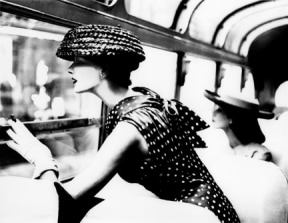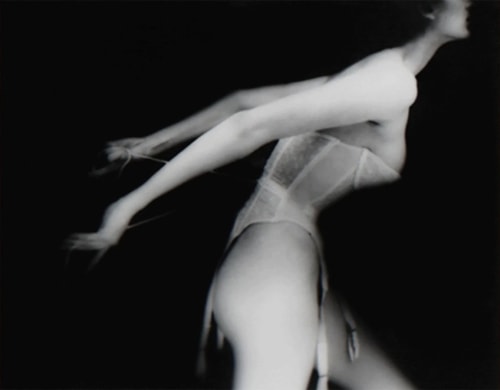

The first woman to break into the macho world of fashion photography is still working at 93. She talks about a lifetime behind the lens
You can’t imagine Lillian Bassman’s photographs appearing in fashion magazines today, which is more our loss than hers. From the Forties to the Sixties, her astonishingly beautiful images, taken first for Junior Bazaar, then Harper’s Bazaar, revealed Dior’s New Look silhouette at its ghostliest and most glamorous.
Her sensuous black-and-white pictures, a selection of which are about to go on show at the Donna Karan store in London, are striking less for the clothes or the models than for their daring, innovative artistry. Bassman deliberately made her images grainy in the darkroom: models in underwear and corsets appear like wraiths; a picture of an evening gown is more memorable for the ecstasy on the model’s face than the cut of its hem; bodies blur and the angles of shoulders are softened. But Bassman scoffs when asked if she enjoyed the glamorous clothes she was photographing. “No, I made all my own clothes. To me, daytimes were about wearing shirts and jeans. I only bought one dress in my life and it fell apart pretty quickly.”
Bassman, 93, was one of the finest and most respected photographers of her generation (Richard Avedon lent her his studio). It’s an achievement given an extra edge by her gender: she worked almost exclusively around men and acknowledges that her photographs were different because the models felt at ease. There wasn’t the “sexual charge” that characterised the studios run by her male peers. “The models always felt I was one of them. They would tell me their stories as they had their hair and make-up done. They never had to seduce me in the way they had to seduce men.”
We meet in Bassman’s Upper East Side home. Prints of her photographs are blown up on the walls above the computer where she still works. She is dressed in a crisp blue shirt with wispy hair and is frail-looking, hooked up day and night to an oxygen tank. Her children, Lizzie, 57, a former New York Times photographer, and Eric, 59, editor-in-chief of Abrams Books, sit with her. Lizzie, who is her mother’s full-time carer and manager, says Bassman had severe bronchitis earlier in the year and is suffering from the onset of seasonal allergies.
Bassman coughs, wheezes, speaks slowly. But the air of rickety vulnerability is deceptive: she is a sharp, unsentimental raconteur and more interested in “getting on with the next job” – manipulating images from her archive in Photoshop for new exhibitions or books – than luxuriating in nostalgia.
Bassman was born in Brooklyn and raised in the Bronx and later Greenwich Village. Her parents were arty Russian emigrés. Her father Julius was a workaholic “fancy house painter”, her mother Clara “a spoilt housewife, flirtatious, which my father said he never minded but I’m sure he did. He was a slave to the woman he loved. She was considered beautiful and given to affairs, I’m sure.” Her sister Sunny was four years her senior. “She sort of brought me up. She took me out with her friends.” It was a bohemian, “liberal, cultured, marvellous” household. Lillian and Sunny had dance lessons and imagined that they were Isadora Duncan. An injury stopped Bassman from becoming a dancer. “I cried for a while, then forgot about it. And boys, they helped.”
She met her future husband, Paul Himmel, when she was 6 and he 9: his parents had a restaurant at a resort where her mother waitressed, and he “almost drowned” her by dunkingher head in the sea. The next time they met, she was 13. “I’m not sure it was love at first sight, but on my part there was a desire to intrigue him.”
They moved in together when she was 15 and he 18 and married 3 years later. Did their parents mind the age gap? Lizzie interjects. “Well, they couldn’t. My father’s father and my mother’s mother ran off and had an affair after my parents got together. The children were left to take care of the abandoned spouse on either side. My father and mother spent their youth going to museums, feasting on the Old Masters at the Metropolitan Museum of Art. My father was responsible for my mother’s education in terms of getting her out of high school, which she hated. He tutored her in maths. It was a tempestuous love. She was never interested in children until she had us later.”
In her late teens Bassman became a life model: the instructor would draw on her so students could capture bodily movement. Later she painted murals for the Works Progress Administration during the Depression. By 21, when her mother was naturalised as a US citizen, Bassman wrote on the documentation her occupation as “artist”. Himmel was a photographer and, while he also photographed fashion, he became better known for reportage. The couple would set up a joint studio in 1951.
Bassman studied at the Textile High School and Pratt Institute, a friend encouraging her in 1940 to show her fashion illustrations to Alexey Brodovitch, the art director of Harper’s Bazaar, who awarded her a full scholarship to a class he taught. He made her his apprentice at Harper’s, then edited by Carmel Snow. “During lunchtimes I would go into [the photographer, George] Hoyningen-Huene’s studio and experiment making prints,” recalls Bassman. “I have no idea where my inspiration came from, but I had the desire to change the hard-edged dimensions of an image. I used to take tissue paper and a spatula and work on it, so the periphery of the image was softened. I didn’t, still don’t, see colour. I see black and white. Look at the early Italian painters: though there is colour, what is memorable is the contrast.” In the darkroom she burned and bleached images. “She was always happier making the print than taking the image,” notes Eric.
Her first fashion picture was published in Junior Bazaar in 1946. Three years later, she went with Snow to photograph the Paris collections. Snow told her to focus on the “buttons and bows”, not on creating art. “Before that no one gave me couture to photograph,” says Bassman. “It was thought I could make anything look passable, which I did by pinning a dress carefully and directing a model. My mother was a seamstress and I have made my own clothes all my life. Couture didn’t exist for me. I didn’t think it was exciting.”
Where her husband took photographs for money, for Bassman it was “a vocation”. Their marriage had its problems, she says, but they were each other’s confidantes and best friends. Photographs of them as a (younger and older) couple thrum with desire and a deep connection. “I adored him,” says Bassman. “There were minor flirtations here and there, just for fun, nothing serious.” He also drank, and when he felt he was at the end of his career as a photographer he destroyed much of his archive, then retrained as a psychotherapist.
Lizzie remembers her mother’s studio as a riot of objects: “One day a forest of feather boas, the next a musical fountain, but I did feel competitive with the models for my mother’s attention.” Eric recalls his mother buying a fridge and painting it: “For her, there is nothing you can’t alter to suit your tastes. At the weekend we’d buy objects to put into collages.”
She initially hung up her camera in the mid-Seventies. “Models were coming in and just striking a, b and c: staple poses,” Bassman says. “I said, ‘Forget it. This is not how I work.’ For me it was about gesture, the neck, throat, the arch of the back.” In 1976, she began designing clothes for luxury store Neiman Marcus. “I enjoyed it until it became a business. I wanted no part of that.”
Bassman didn’t destroy her work like her husband, but put her negatives and prints into rubbish bags. This wasn’t done in a fit of pique, Bassman says (Eric isn’t so sure), but to clear space for a tenant, the abstract expressionist painter Helen Frankenthaler. They resurfaced 20 years later, when Frankenthaler found them. A resurgence of interest in Bassman’s work meant she accepted photographic commissions from the New York Times fashion pages in 1996.
She shot her final fashion shoot in 2004: she started hating the clothes and the work was too physically demanding. Bassman recalls one day booking a 28-year-old model, but a younger replacement was sent, “with a beautiful body, but the face of a 12-year-old and I couldn’t face the fact you had this ‘child’ modelling clothes that a woman in her thirties should wear. An older model would give the dress the authority it needed. That was my last shoot.” She doesn’t look at fashion magazines today, though has enjoyed “every moment” of her revival and relishes modifying old pictures on the computer as much as she loved the darkroom. Does Bassman miss the darkroom? “How do you explain exuberance? In there I felt a sense of being able to say something I wanted to say.”
Seeing her work exhibited on gallery walls elicits ambivalence. “There are things that I think are marvellous,” says Bassman, “and there are also pictures where I look at a particular crop and think, ‘How awful, I couldn’t have done that.’ It’s mediocre.” She smiles equably. “But are you ever completely happy? No, thank goodness, or you’d stop. I think I’ll go on for ever. When I’m 101, I’ll stop. I don’t think about my own death. I read the obituary pages because people have had such interesting lives, but I don’t see myself on those pages. I don’t see myself dying. I have no fear of it. I go on day by day, happy that the kids are here all the time. Both of them are marvellous: they pay attention to their mother like I never paid attention to my parents, ha ha. I think, ‘What did I do right, that they’re still paying attention to me?’ But they do.”
“You’re good company,” says Eric softly.
“You’re not boring,” adds Lizzie.
Himmel died aged 96, after a stroke, in February 2009. “She is still furious with him,” says Lizzie. “He wasn’t supposed to go first. But she has never lived in the past. She lives in the moment. It makes her able to work.”
Eric recalls a couple of months ago, looking at her lying in bed looking “like a squashed cabbage”, and asking what she was thinking about. She said, “I’m thinking about this picture I want to finish when I’m well enough.”